2017 MERCEDES-BENZ S-CLASS CABRIOLET warning
[x] Cancel search: warningPage 376 of 521
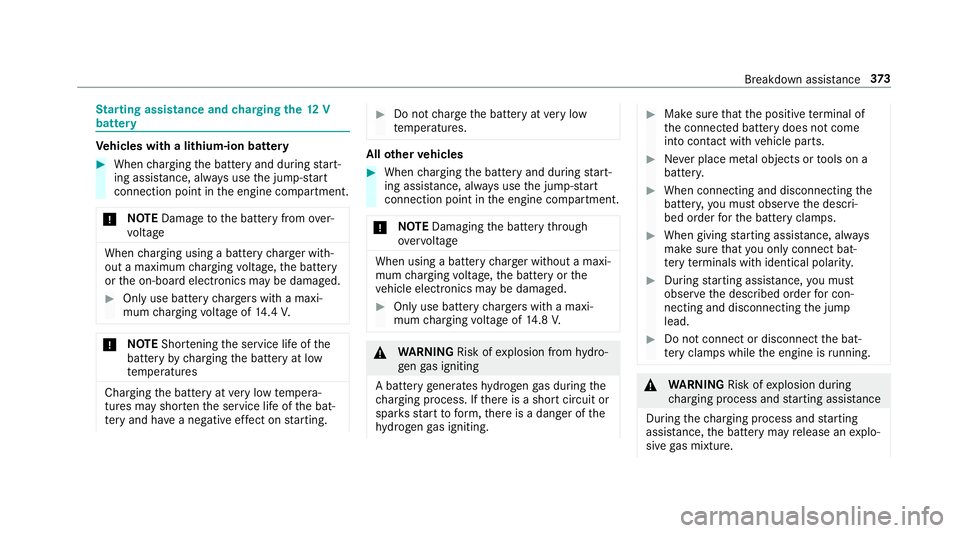
St
arting assi stance and chargin gthe 12 V
battery Ve
hicles with alithium-ion battery #
When chargin gthe batter yand during start‐
ing assis tance, al ways use thej ump-s tart
connection point in thee ngine compartment.
* NO
TEDama getotheb atter yfromo ver‐
vo ltage When
chargin gusingab atte ry charge rw ith‐
out amaximu mcharging voltage, theb attery
or theo n-boar delectronics ma ybedamaged. #
Onlyuse batter ycharger switham axi‐
mum chargin gvoltag eof1 4.4V. *
NO
TEShor tening thes ervice lif eofthe
batter ybycharging theb atter yatl ow
te mp eratures Chargin
gthe batter yatveryl ow temp era‐
tures ma yshor tent he service lif eofthe bat‐
te ry and ha vean egativ eeffect on starting. #
Do no tcharg ethe batter yatveryl ow
te mp eratures. All
other vehicles #
When chargin gthe batter yand during start‐
ing assis tance, al ways use thej ump-s tart
connection point in thee ngine compartment.
* NO
TEDamaging theb atter ythrough
ove rvoltage When using
abatter ychar gerw ithout amaxi‐
mum chargin gvoltage, theb atter yort he
ve hicle electronics ma ybedamaged. #
Onlyuse batter ycharger switham axi‐
mum chargin gvoltag eof1 4.8V. &
WARNING Risk ofexplosion from hydro‐
ge ng as igniting
Ab atter ygene ratesh ydrogen gasd uring the
ch argin gprocess. If ther eisas hortcircuit or
spar ksstar ttof orm, ther eisad anger of the
hy drogen gasigniting. #
Mak esuret hat thep ositiv eterminal of
th ec onnected batter ydoes no tcome
int oc ontact wi thvehicle parts. #
Neverp lace me talo bject sort ools on a
batter y. #
When connectin gand disconnectin gthe
batter y,yo um usto bse rvet he descri‐
bed order fort he batter yclamps. #
When giving startin gassis tance, al ways
mak esuret hat youo nly connec tbat‐
te ry term inals wit hidentical polarity. #
During startin gassis tance, youm ust
obse rvet he described order forc on‐
necting and disconnecting thej ump
lead. #
Do no tconnect or disconnect theb at‐
te ry cla mp sw hile thee ngine is running. &
WARNING Risk ofexplosion during
ch argin gprocess and startin gassis tance
During thec harging process and starting
assis tance, theb atter ymayrelease an explo‐
siv eg as mixture. Breakdown assis
tance 373
Page 377 of 521

#
Avoid fire ,n aked flames ,creating
spar ksand smoking. #
Mak esuret hat ther eiss ufficient venti‐
latio ndurin gthe chargin gprocess and
during startin gassis tance. #
Do no tlea no verab atter y. If
th ei ndicator/warning lamps in thei nstrument
clus terdon otlight up at lo wtemperatures, it is
ve ry likel ythat thed ischar gedb atter yhas fro‐
zen. &
WARNING Risk ofexplosion from afro‐
zen battery
Ad ischar gedb atter ymayfreeze at temp era‐
tures slightl yabove or belo wfreezing point.
During startin gassis tance or batter ycharg‐
ing, batter ygas ma ybereleased. #
Alw ayst hawaf roze nb atte ry out first
befor echarging it or per form ing start‐
ing assis tance. The service li
feof ab atter ythat has been
th awe dmaybe dramaticall yshor tened. It is
recommended that youh ave athawe db at‐
te ry checkedataq ualified specialis tworks hop.
All vehicles
* NO
TEDama gecaused bynumerou sor
ex tende dattem ptstos tart thee ngine Nume
rous or extende dattem ptstos tart the
engine ma ydamag ethe catalytic con verter
due tonon-combu sted fuel. #
Avoid numerous and extende dattem pts
to star tt he engine. Obser
vethef ollowing points during starting
assis tance and when chargin gthe battery:
R Onlyuse undamaged jum plead/charging
cables wit hasufficient cross-section and
insula tedt erminal clamps.
R Non- insulated parts of thet erminal clamps
mus tnotcom eintoc ontac twitho ther me tal
parts while thej um plead/charging cable is
connected totheb attery/jump-s tart connec‐
tion point. R
The jum plead/c harging cable mus tnot
come int ocontact wi thanyp arts whic hmay
mo vewhen thee ngine is running.
R Alw aysm akes uret hat neither youn orthe
batter yiselectrost aticall ychar ged.
R Keep away from fire and naked flames.
R Do no tlean overthe batter y.
R When charging: only use batter ychargers
te sted and appr ovedbyM ercedes-Benz, and
please read theb atter ychar ger's operating
instructions befor echarging theb atter y.
Obser vethea dditional following point sduring
st artin gassis tance:
R Startin gassis tance ma yonly be pr ovided
using batteries wit hanominal voltag eof
12 V.
R The vehicles mus tnottouch.
R Petrol engine: only acceptstartin gassis‐
ta nce if thee ngine and exhaus tsystema re
cold. #
Secur ethe vehicle byapplying thee lectric
parking brake. 374
Breakdown assis tance
Page 380 of 521
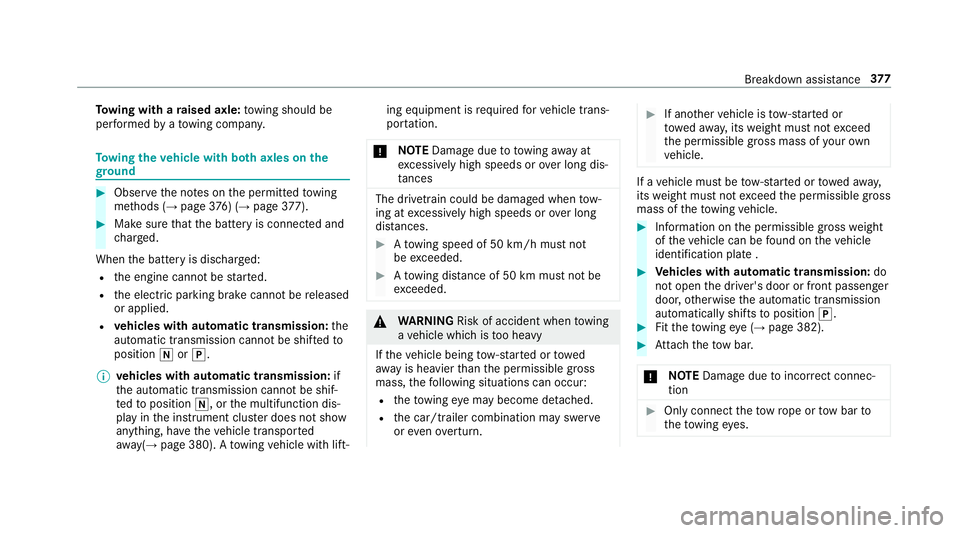
To
wing wit haraisedaxle: towing should be
per form ed byatow ing compan y. To
wing thev ehicle wit hbotha xlesont he
gr ound #
Obser vethen otes on thep ermitted towing
me thods (→ page376)(→pag e377). #
Mak esuret hat theb atter yisc onnected and
ch arge d.
When theb atter yisd ischar ged:
R thee ngine cann otbe star ted.
R thee lectric parking brak ecann otbe released
or applied.
R vehicles with automatic transmission: the
automatic transmission canno tbeshiftedto
position iorj.
% vehicles with automatic transmission: if
th ea utomatic transmission cann otbe shif‐
te dtop osition i,ort he multifunction dis‐
pla yint he instrument clus terd oes no tshow
anything, ha vethev ehicle transpor ted
aw ay( →pag e380). Atow ing vehicle wit hlift‐ ing equipment is
requiredforv ehicle trans‐
por tation.
* NO
TEDama gedue to to wing away at
exc essively high speeds or over long dis‐
ta nces The driv
etra in could be damaged when tow‐
ing at excessively high speeds or over long
dis tances. #
Atow ing speed of 50 km/h mus tnot
be exc eeded. #
Atow ing dis tance of 50 km mu stnotbe
exc eeded. &
WARNING Risk of accident whe ntow ing
av ehicle whic histoo heavy
If th ev ehicle being tow- star tedort owed
aw ay is heavier than thep ermissible gross
mass, thef ollowing situations can occur:
R thet ow ing eyem aybecome de tach ed.
R thec ar/t railer combination ma yswe rve
or eve noverturn. #
If ano ther vehicle is tow- star tedor
to we da way,its weight mus tnotexc eed
th ep ermissible gross mass of your own
ve hicle. If
av ehicle mus tbetow-sta rted or towe da way,
its weight mus tnotexc eed thep ermissible gross
mass of thet ow ing vehicle. #
Information on thep ermissible gross weight
of thev ehicle can be found on thev ehicle
identification plat e. #
Vehicles with automatic transmission: do
no to pen thed rive r's door or front passenger
door ,otherwise thea utomatic transmission
automaticall yshifts toposition j. #
Fitthet ow ing eye( →pag e382). #
Attach thet ow bar.
* NO
TEDama gedue toincor rect connec‐
tion #
Onlyconnect thet ow ro pe or towb arto
th et ow ing eyes. Breakdown assis
tance 377
Page 381 of 521
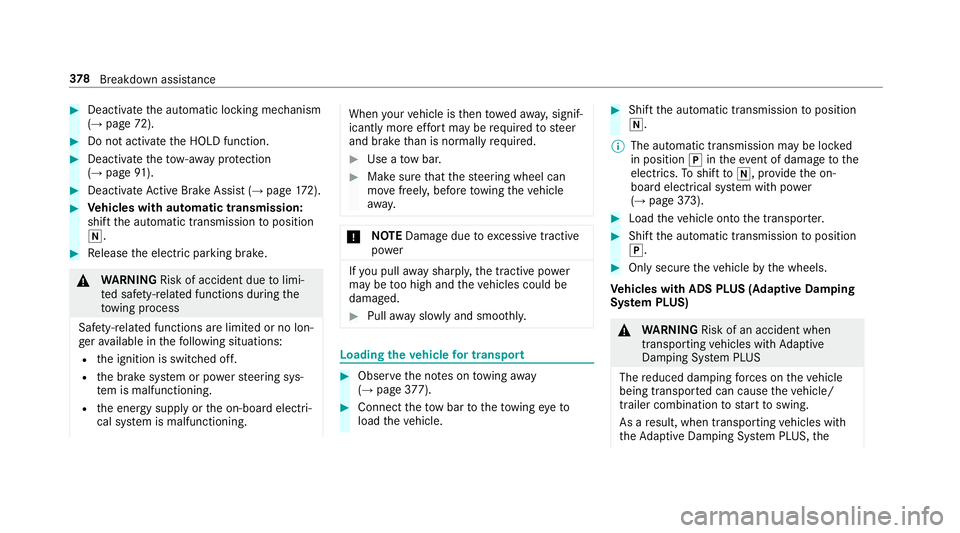
#
Deactivat ethe automatic locking mechanism
(→ pag e72). #
Do no tactivat ethe HOLD function. #
Deactivat ethe tow- aw ay protection
(→ pag e91). #
Deactivat eActiv eBrake Assi st (→pag e172). #
Vehicles with automatic transmission:
shif tthe automatic transmission toposition
i. #
Release thee lectric parking brake. &
WARNING Risk of accident du etolimi‐
te ds afet y-re lated function sduring the
to wing process
Saf ety-re lated function sarelimited or no lon‐
ge ra vailable in thef ollowing situations:
R thei gnition is switched off.
R theb rake system or po wersteering sys‐
te mism alfunctioning.
R thee nergy supply or theo n-boar delectri‐
cal sy stem is malfunctioning. When
your vehicle is then towe da way,signif‐
icantly mor eeffor tm aybe requ ired tosteer
and brak ethan is normall yrequired. #
Use atow bar. #
Mak esuret hat thes teering wheel can
mo vefreely ,befor etow ing thev ehicle
aw ay. *
NO
TEDama gedue toexcessiv etracti ve
po wer If
yo up ullaway sharpl y,thet ractiv epower
ma ybet oo high and thev ehicles could be
damaged. #
Pull away slowl yand smoo thly. Loading the
vehicl efor transport #
Obser vethen otes on towing away
( → pag e377). #
Con nect thet ow bar tothet ow ing eyeto
load thev ehicle. #
Shif tthe automatic transmission toposition
i.
% The automatic transmission ma ybelocked
in position jinthee vent of dama getothe
electrics. Toshif tto i,provide theo n-
boar delectrical sy stem wit hpower
( → pag e373). #
Load thev ehicle ont othe transpor ter. #
Shif tthe automatic transmission toposition
j. #
Onlysecur ethe vehicle bythew heels.
Ve hicles with ADSP LUS(Ad aptiv eDamping
Sy stem PLUS) &
WARNING Risk of an accident when
transporting vehicles wit hAdaptive
Damping Sy stem PLUS
The reduced damping forc es on thev ehicle
being transpor tedc an cause thev ehicle/
trailer combinatio ntostart to swing.
As aresult, when transporting vehicles with
th eA daptiv eDampin gSystemP LUS,the 378
Breakdown assis tance
Page 384 of 521

*
NO
TEDama gedue toincor rect us eof
th et ow ing eye When
atow ing eyeisu sedtoreco verav ehi‐
cle, thev ehicle ma ybedamaged in thep roc‐
ess. #
Onlyusethet ow ing eyetot owaway or
to ws tartthe vehicle. To
w- starting thev ehicle (emer gency engine
st arting) Ve
hicles with automatic transmission
* NO
TEDama getothea utomatic trans‐
mission due to tow-starting The automatic transmissio
nmaybe damaged
in thep rocess of tow- startin gvehicles with
automatic transmission. #
Vehicles wit hautomatic transmission
mus tnotbe tow- star ted. #
Vehicles wit hautomatic transmission must
no tbet ow-sta rted. Electrical fuses
Note
sone lectrical fuses &
WARNING Risk of accident and inju ry
due to ov erloaded lines
If yo um anipulat eorbridg eaf aulty fuse or if
yo ur eplace it wit hafuse wit hahigher
amperage, thee lectric line could be overloa‐
ded.
This could result in afire. #
Alwa ys replace faulty fuse swiths peci‐
fi ed ne wfuses conta iningthe cor rect
amperage. *
NO
TEDama gecaused byincor rect fuses Incor
rect fuses ma ycause damag etoelectri‐
cal components or sy stems. #
Onlyuse Mercedes-Benz appr oved
fuse switht he cor rect fus erating. Bl
ow nfuses mustbe replaced wit hfuses of the
same rating ,which youc an recognise bythec ol‐
our and fuse rating .The fuse rating sarelist ed in th
ef use assignmen tdiagram. The fuse assign‐
ment diagram is in thev ehicle document wallet.
* NO
TEDama geor malfunctions caused
by moisture Moistur
emaycause dama getothee lectrical
sy stem or cause it tomalfunction. #
When thef use bo xisopen, mak esure
th at no moistur ecan enter thef use
box. #
When closing thef use box, mak esure
th at thes eal of thel id is positioned cor‐
re ctly on thef use box. If
th en ewlyinser tedf use also blo ws,have the
cause trace dand rectifie dataq ualified special‐
is tw orks hop, e.g. aMercedes-Benz Service
Centre.
Ensur ethe following befor ereplacing afuse:
R The vehicle is secured agains trolling away.
R All electrica lconsumer sareswitched off.
R The ignition is switched off. Breakdown assi
stance 381
Page 385 of 521
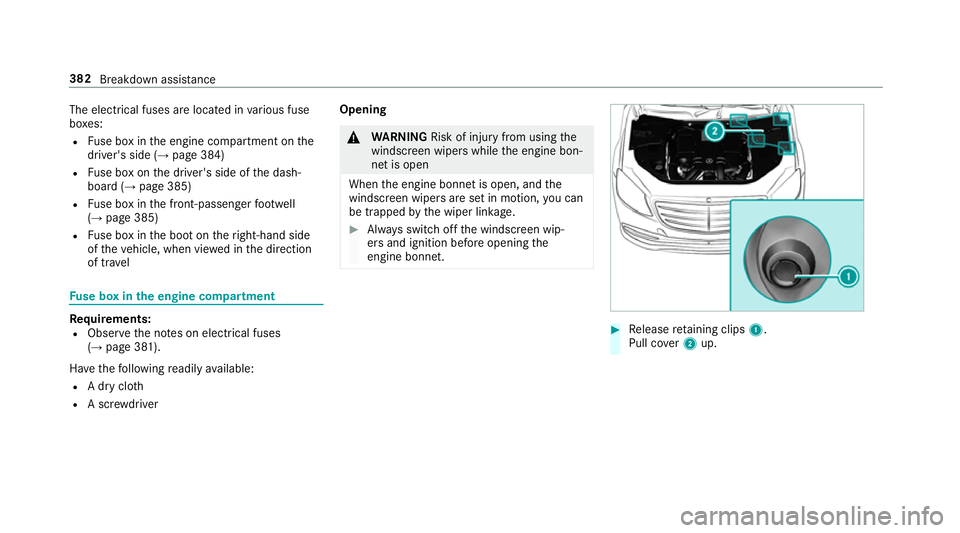
The electrical fuses ar
elocated in various fuse
bo xes:
R Fuse bo xinthe engine compartment on the
driver's side (→ page384)
R Fuse bo xont he driver's side of thed ash‐
boar d(→pag e385)
R Fuse bo xinthe front-passenge rfootwell
(→ pag e385)
R Fuse bo xinthe boo tontheright-hand side
of thev ehicle, when vie wedint he direction
of tra vel Fu
se bo xinthe engine compartment Requ
irements:
R Obser vethen otes on electrical fuses
(→ pag e381).
Ha ve thef ollowing readil yavailable:
R Adryclo th
R Ascrew driver Opening &
WARNING Risk of inju ryfrom using the
windscreen wiper swhile thee ngine bon‐
ne tiso pen
When thee ngine bonn etis open ,and the
windscreen wiper saresetinm otion, youc an
be trapped bythew iper linkage. #
Alw ayss witc hoffthew indscreen wip‐
er sa nd ignition befor eopening the
engine bonn et. #
Release retainin gclips 1.
Pull co ver2up. 382
Breakdown assi stance
Page 387 of 521
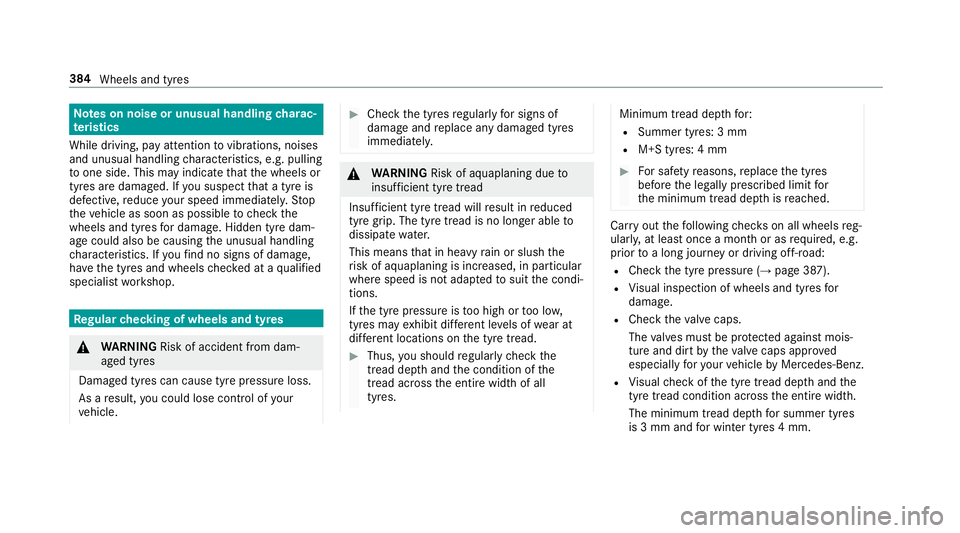
Note
sonn oise or unusua lhandling charac‐
te rist ics
While driving ,pay attention tovibrations, noises
and unusual handling characteristics, e.g .pulling
to one side. This ma yindicat ethat thew heels or
tyres ar edamaged. If yous uspect that at yreis
defective, reduce your spee dimmediatel y.Stop
th ev ehicle as soon as possible tocheckt he
wheels and tyres ford ama ge.H idden tyr edam‐
ag ec ould also be causing theu nusual handling
ch aracteristics. If youf ind no sign sofdamage,
ha ve thet yres and wheels checkedataq ualified
specialis tworks hop. Re
gular checking of wheels and ty res&
WARNING Risk of accident from dam‐
aged tyres
Dama gedt yres can cause tyr epressur eloss.
As aresult, youc ould lose cont rolofy our
ve hicle. #
Chec kthe tyres regularly fors igns of
dama geand replace an ydamaged tyres
immediatel y. &
WARNING Risk of aquaplaning du eto
insuf ficient tyr etread
Insu fficien ttyret read will result in reduced
tyr eg rip. The tyr etread is no longer able to
dissipat ewater.
This mean sthat in heavy rain or slush the
ri sk of aquaplaning is increased, in particular
wher espeed is no tadap tedtos uitthec ondi‐
tions.
If th et yrep ressur eist oo high or tool ow,
tyres ma yexhibit dif fere nt le vels of wear at
dif fere nt locations on thet yret read. #
Thus, yous hould regularly checkt he
tread dep thand thec ondition of the
trea dacross thee ntir ew idthofa ll
tyres. Minimum tread dep
thfor:
R Summer tyres: 3mm
R M+S tyres: 4mm #
Fors afet yr easons, replace thet yres
befor ethe legally prescribed limit for
th em inimum tread dep thisreached. Car
ryout thef ollowing checks on all wheels reg‐
ularly ,atleastonce amonthorasr equired, e.g.
prior toalon gjou rney or drivin goff-roa d:
R Chec kthe tyr epressur e(→pag e387).
R Visual inspection of wheels and tyres for
damage.
R Chec kthe valvec aps.
The valves mus tbeprotected agains tmois‐
tur ea nd dir tbythevalvec aps appr oved
especially fory our vehicle byMercedes-Benz.
R Visual checkoft he tyr etread dep thand the
tyr etread condition across thee ntir ew idth.
The minimum tread dep thfors ummer tyres
is 3mma ndforw inter tyres 4mm. 384
Wheel sand tyres
Page 388 of 521
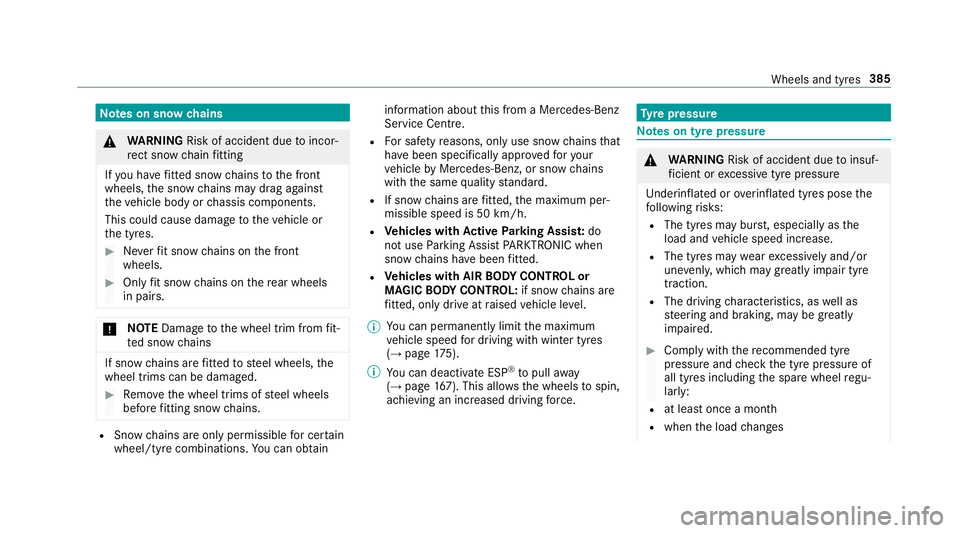
Note
sons nowc hains &
WARNING Risk of accident du etoincor‐
re ct sno wchain fitting
If yo uh ave fitted sno wchains tothef ront
wheels, thes nowc hains ma ydraga gainst
th ev ehicle body or chassis components.
This coul dcaus edamag etothevehicle or
th et yres. #
Neverfit sn ow ch ains on thef ront
wheels. #
Onlyfit sn ow ch ains on ther ear wheels
in pairs. *
NO
TEDama getothew heel trim from fit‐
te ds nowc hains If sno
wchains ar efitted tosteel wheels, the
wheel trims can be damaged. #
Remo vethew heel trims of steel wheels
befor efittin gsnowc hains. R
Sno wchains ar eonly pe rmissible forc ertain
wheel/tyr ecombinations .You can obtain information aboutt
his fromaMercedes-Benz
Service Cent re.
R Fors afet yr easons, onl yuse sn owchains that
ha ve been specifically appr ovedfor your
ve hicle byMercedes-Benz, or sno wchains
wit hthe same qualit ystandard.
R If sn owchains ar efitted, them aximum per‐
missible speed is 50 km/h.
R Vehicles with Activ eP arking Assis t:do
no tu se Parking Assis tPARKTRONIC when
sno wchains ha vebeen fitted.
R Vehicles with AIRB ODYC ONT ROLor
MAGIC BODY CONT ROL:if sn ow ch ains are
fi tted ,only driv eatraised vehicle le vel.
% Youc an permanentl ylimit them aximum
ve hicle speed ford riving wit hwinter tyres
(→ pag e175).
% Youc an deactivat eESP®
to pull away
( → pag e167). This allo ws thewheels tospin,
achieving an increased driving forc e. Ty
re pressure Note
sont yrep ressure &
WARNING Risk of accident du etoinsuf‐
fi cient or excessiv etyrep ressure
Underinfla tedoro verinfla tedt yres pose the
fo llowing risks:
R The tyres ma yburst,e speciall yasthe
load and vehicle speed increase.
R The tyres ma ywear excessivel yand/or
une venly, whic hmaygreatly impair tyre
traction.
R The drivin gcharacteristics, as well as
st eering and braking, ma ybegreatly
impaired. #
Comply wit hthe recommended tyre
pressur eand checkt he tyr epressur eof
all tyres including thes par ew heel regu‐
larly:
R at leas tonce amonth
R when thel oad changes Wheels and tyres
385